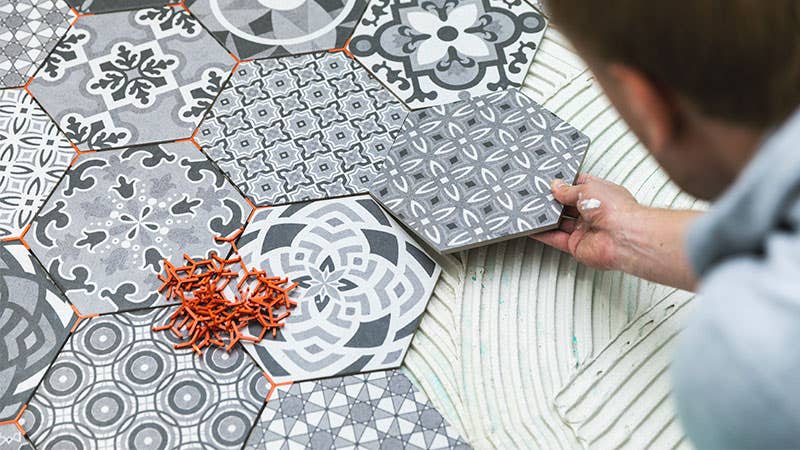How much does it cost to install tile?

The Bankrate promise
At Bankrate we strive to help you make smarter financial decisions. While we adhere to strict , this post may contain references to products from our partners. Here's an explanation for .
Key takeaways
- The average cost for tile installation ranges from $825 to $2,520.
- Personal loans, credit cards and HELOCs can cover the cost of tile installation.
- Factor both material costs and labor into your budget.
The cost to install new tiles depends on the project and the amount of customization you choose. The overall price tag for a tiling project can swing from $300 to $17,500, according to HomeGuide. But most jobs fall within the $2,000 to $10,000 range.
While you may be able to DIY and save up for smaller projects, you may want to consider other financing options if you plan on redoing your kitchen backsplash or retiling your en suite. Have a plan in place for exactly what you want done, then get estimates from contractors to determine how much it will cost to install tile in your home.
Tile installation cost breakdown
Like many home improvement projects, the price tag for installing new tiling breaks down into materials and labor. In general, the tiles themselves typically cost between $2 to $10 per square foot, while the actual installation costs range from $5 to $14 per square foot.
Six factors influence how much tile installation will cost.
- Room size: Tile installation is priced per square foot. The larger the area you want to tile, the more you can expect to pay. You will also need to account for waste and breakage, so overestimate your room size by at least 10 percent to act as a contingency.
- Room layout: Tile needs to be cut to fit around corners and curves. If the room has a simple floor plan, the installation will be cheaper — and you could potentially DIY it. If the layout is unusual and requires a lot of cutting, you should expect higher labor costs.
- Tile size: Smaller tiles usually cost less than larger ones, although you will need to buy more to cover the same area.
- Tile material: Ceramic tiles are often the most durable, but not the most affordable choice, ranging from $7 to $45 per square foot. Vinyl and linoleum are less expensive, typically starting around $2 or $3 per square foot.
- Installation: The labor costs will vary based on the room layout and the material.
- Custom work: Any individualizing of the tile layout — such as the creation of borders, medallions or mosaics — will increase the final tab significantly over installing “straight tile.”
Tips to save on tile installation
Choosing less expensive tiles, requesting multiple quotes and doing some labor yourself can help keep your tile installation affordable.
- Get multiple estimates: Asking for quotes won’t just give you a clearer picture of the final bill. It will also help you choose the most affordable contractor. Make sure to give each contractor the same information so you can feel confident you’re making apples-to-apples comparisons.
- Choose smaller, more basic tiles: In general, smaller tiles are more affordable than larger ones. They tend to require less cutting, which saves time and decreases labor costs.
- Limit your coverage area: Since the price to install tile is calculated per square foot, the smaller the area you cover, the less you pay. If you’re being budget conscious, you may want to consider tiling only a small area.
- Avoid customization: Any customization work is bound to be labor-intensive and significantly increase the overall cost of your tile installation. If budget is your main concern, skip a fancy or unique design and opt for a more straightforward pattern instead.
- Go DIY: Most of the installation cost for tile comes from labor. If you’re handy and think you can achieve a professional-looking result, this may be one project worth doing on your own. Just be careful and do your homework to avoid making costly mistakes.
How does tile installation impact your home value?
As with any home improvement project, installing tile makes the most sense when it positively impacts your home’s value. According to Realtor.com, installing tile in your home offers a 50 to 70 percent return on investment. The key is the type of tile you choose to install. In particular, ceramic tile has the best ROI — 70 percent on average — especially when you install it yourself.
Tile doesn’t always have a positive impact on home value, though. Bold colors or wild patterns can go out of style quickly. Stick to neutral colors and steer away from tiling trends if you are trying to add lasting value to a home.
Keep in mind that tile is not the most valuable flooring material. Wood floors offer a bigger bang for the investment buck, recouping 70 to 80 percent of their cost.
Tile installation financing options
While installing tiling isn’t the most expensive of home remodeling projects, you still might want to finance it, especially if it’s a four-figure job.
Personal loan
If you don’t have much equity in your home, getting a personal loan may be your best option for financing the cost to lay tile. Personal loans are installment loans, which means you’ll receive the money in one lump sum and then make fixed, regular payments until it’s paid off. They are also unsecured, meaning that instead of being tied to an asset like your home, approval is based largely on your credit score.
That said, be aware that some personal loans come with high interest rates because they’re not backed by any collateral. If you choose to go this route for your financing, be sure to get estimates first and only borrow as much as you need.
Home equity loan
If you’ve been paying down your mortgage for a while, a home equity loan may be a better option. Like a personal loan, you’ll receive the money in one lump sum and make fixed payments.
However, there’s a good chance you’ll get a better interest rate with a home equity loan. But since a home equity loan is secured by the value of your home, you could be putting your home at risk if you fail to make payments on time.
A home equity loan is a smart choice for tile installation because you’ll be leveraging your ownership in the house to do something that positively impacts its value. Also, the interest could be tax-deductible if you choose to itemize deductions.
Home equity line of credit
A home equity line of credit (HELOC) works more like a credit card than an installment loan. In this case, you’ll be granted a certain amount of time — usually 10 years — where you can borrow against the value of your home as needed.
During that time, you’ll likely only have to make payments on the interest on what you’ve borrowed. Then, after that borrowing period is over, you’ll start making payments on both the principal loan balance and the interest.
HELOCs traditionally have variable interest rates, but more lenders are starting to offer fixed interest rate options, priced about the same as home equity loans.
Using a home equity line of credit is a smart choice if installing tile is only one of a few home improvement projects you plan to complete. The flexibility of a HELOC makes it ideal for balancing multiple projects.
Credit card
A credit card — especially a 0 percent interest rate card — may be a good option for small projects. There are dozens of options available with plenty of rewards programs. You can also limit costs by paying down as much as you can before interest kicks in.
And if you already have a credit card, you won’t need to apply for any additional funding. As long as your credit limit is large enough to cover the costs, you can avoid a hard credit check to keep your credit score intact.
Related Articles



